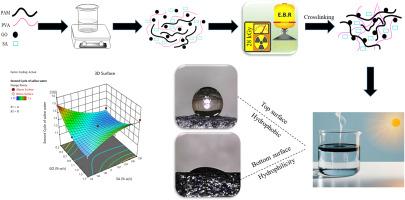电子束交联PVA/PAM/GO/SA水凝胶高效太阳能脱盐:协同设计与性能优化
IF 6.3
2区 材料科学
Q2 ENERGY & FUELS
引用次数: 0
摘要
为了应对全球淡水短缺的挑战,本研究提出了一种由聚乙烯醇(PVA)、聚丙烯酰胺(PAM)、氧化石墨烯(GO)和二氧化硅气凝胶(SA)组成的光热水凝胶复合材料,该材料采用电子束(e-beam)交联制备,是一种清洁且无添加剂的工艺。材料表征方法,包括傅里叶变换红外光谱(FTIR)、扫描电子显微镜(SEM)、能量色散x射线光谱(EDS)、接触角分析、膨胀行为和压缩载荷,证明了具有均匀纳米材料分散和不对称润湿性梯度的结构弹性、各向异性水凝胶的形成。采用响应面法(RSM)优化氧化石墨烯(GO)和水杨酸(SA)在盐水条件下第二循环的浓度,以最大限度地提高盐水体系中的蒸发速率。以0.3% (w/v)氧化石墨烯和1.4% (w/v) SA为优化条件,在日光环境下蒸馏水和盐水的单太阳标准化蒸发速率分别为1.54±0.02 kgm−2h−1和1.50±0.03 kgm−2h−1。氧化石墨烯的加入增强了光热吸收,提高了水凝胶基质的机械稳定性,而SA提供了浮力,有助于限制热损失。水凝胶在负载下保持结构强度,表现出高吸水性,并能够持续表面加热。这些协同特性支持稳定和高效的太阳能驱动界面蒸发。电子束辐照是一种可扩展的绿色交联工艺,避免了传统化学交联剂所需要的有毒化学添加剂。这项工作展示了一种实用、稳定、轻便、高效的聚合物水凝胶平台,用于太阳能海水淡化,支持在能源有限的环境中部署,并有助于可持续的淡水生产。本文章由计算机程序翻译,如有差异,请以英文原文为准。

Electron beam crosslinked PVA/PAM/GO/SA hydrogel for high-efficiency solar desalination: Synergistic design and performance optimization
To address the global freshwater scarcity challenge, this study presents a photothermal hydrogel composite composed of polyvinyl alcohol (PVA), polyacrylamide (PAM), graphene oxide (GO), and silica aerogel (SA), fabricated using electron-beam (e-beam) crosslinking as a clean and additive-free process. Material characterization methods, including Fourier-transform infrared spectroscopy (FTIR), scanning electron microscopy (SEM), energy-dispersive X-ray spectroscopy (EDS), contact angle analysis, swelling behavior, and compressive loading, demonstrated the formation of a structurally resilient, anisotropic hydrogel with uniform nanomaterial dispersion and an asymmetric wettability gradient. Response surface methodology (RSM) was employed to maximize the evaporation rates in saline systems by optimizing the concentration of GO and SA in the second cycle under saline conditions. The optimized condition with 0.3 % (w/v) GO and 1.4 % (w/v) SA delivered one-sun–normalized evaporation rates of 1.54 ± 0.02 kgm−2h−1 in the distilled water and 1.50 ± 0.03 kg m−2h−1 in the saline water under ambient sunlight. GO incorporation enhanced photothermal absorption and improved the mechanical stability of the hydrogel matrix, while SA provided buoyancy and helped limit heat loss. The hydrogel retained structural strength under load, demonstrated high water uptake, and enabled sustained surface heating. These synergistic features supported stable and efficient solar-driven interfacial evaporation. E-beam irradiation is a scalable and green crosslinking process that avoids toxic chemical additives required in conventional chemical crosslinkers. This work demonstrates a practical, stable, lightweight, high efficiency polymer hydrogel platform for solar desalination, supporting deployment in energy-limited settings and contributing to sustainable freshwater production.
求助全文
通过发布文献求助,成功后即可免费获取论文全文。
去求助
来源期刊

Solar Energy Materials and Solar Cells
工程技术-材料科学:综合
CiteScore
12.60
自引率
11.60%
发文量
513
审稿时长
47 days
期刊介绍:
Solar Energy Materials & Solar Cells is intended as a vehicle for the dissemination of research results on materials science and technology related to photovoltaic, photothermal and photoelectrochemical solar energy conversion. Materials science is taken in the broadest possible sense and encompasses physics, chemistry, optics, materials fabrication and analysis for all types of materials.
 求助内容:
求助内容: 应助结果提醒方式:
应助结果提醒方式:


